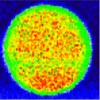Distribution, that's the name of the game
by David Bradley
Distributed computing has already entered the popular psyche through the likes of the SETI@home experiment and various
protein folding and drug interaction projects, such as IBM's recently
announced venture which utilise the CPU idle time of hundreds of thousands of desktop computers around the world. The CombeChem team, have used such a distributed computing network, a Grid,
within the University of Southampton to run simulations and to allow the team to compile a large database of molecules.
 The database contains the structure, name
and properties, such as melting point, pKa, and calculated properties. The
researchers have built software agents, so-called Comberobots, which
continually scan the database for empty fields and automatically submit
simulations to calculate unknowns. The simulations themselves run on the
Grid by stealing the spare cycles from the University network of computers,
which ranges from powerful Linux servers to underused Windows-based PCs.
The database contains the structure, name
and properties, such as melting point, pKa, and calculated properties. The
researchers have built software agents, so-called Comberobots, which
continually scan the database for empty fields and automatically submit
simulations to calculate unknowns. The simulations themselves run on the
Grid by stealing the spare cycles from the University network of computers,
which ranges from powerful Linux servers to underused Windows-based PCs.
The team has also developed an application to screen small molecules against protein targets using the Grid, with malaria as their topical example. In addition, they are using the grid to carry out multiple simulations, using replica exchange, to understand how the flexibility of proteins, such as, HIV protease (a viral protein) and nitrogen regulatory protein C (a bacterial protein) affects their structures and thus potential interactions with small molecules. The structures of the small molecules may well have been determined and analysed using the NCS grid service.
One of the biggest successes of the
CombeChem project is the NCS Grid Service. The EPSRC funded National
Crystallography Service (NCS) is a facility available to the entire UK
academic chemistry community. A team of experts using state of the art
instrumentation based at Southampton University provides the exceptionally
important service. Allowing access to crystal structure determination to the
community, which is easily the most information-rich method of
characterising a chemical. Indeed, many research papers cannot be published
without confirmation of identity by crystal structure analysis. The NCS
serves all kinds of users from those with no facilities of their own to
experts with limited resources, but in order to keep pace with increasing
demand, more than 1000 samples are analysed each year at the moment, the
CombeChem is allowing the NCS to develop a pioneering fully automated
crystal structure determining system based on robotic high-throughput of
samples.
Allowing access to crystal structure determination to the
community, which is easily the most information-rich method of
characterising a chemical. Indeed, many research papers cannot be published
without confirmation of identity by crystal structure analysis. The NCS
serves all kinds of users from those with no facilities of their own to
experts with limited resources, but in order to keep pace with increasing
demand, more than 1000 samples are analysed each year at the moment, the
CombeChem is allowing the NCS to develop a pioneering fully automated
crystal structure determining system based on robotic high-throughput of
samples.
The CombeChem Trust Network provides the infrastructure for this automated crystallography experiment, which allows only certified users to access the Grid. Once in, the users can drive the automated experiment themselves. The user will likely have more detailed knowledge of their samples so is the ideal person to purposefully contribute to the crystal structure determination in this way. A major benefit of this approach is not only the possibility of close collaboration with NCS staff when needed, but the removal of overrun staff from the loop when their input is redundant, as is the case with an expert driver.
The Control Service provides the remote user with a portal through which they can run the crystallographic experiment. The display is continuously updated so that the user can see and steer the experiment's progress. The resulting diffraction patterns and together with other raw data are archived and made available published through the portal so that future researchers can both check and if necessary re-use the data.
 Other projects within CombeChem include
eTechniques for Teaching, Crystallographic ePrints, a component of the NCD
Grid Service, and Chemistry at Bristol. All of these have devised novel
Grid-based solutions to problems facing chemists everyday whether
researching, publishing, or teaching. CombeChem itself will provide the
end-to-end connectivity between laboratory experiments, models, analysis and
the literature; making the data traceable and easily and efficiently
re-useable by the next generation of experiments.
Other projects within CombeChem include
eTechniques for Teaching, Crystallographic ePrints, a component of the NCD
Grid Service, and Chemistry at Bristol. All of these have devised novel
Grid-based solutions to problems facing chemists everyday whether
researching, publishing, or teaching. CombeChem itself will provide the
end-to-end connectivity between laboratory experiments, models, analysis and
the literature; making the data traceable and easily and efficiently
re-useable by the next generation of experiments.
Also in Issue 75
Scientists with contractual
obligations, The growing problem of biopiracy,
Deep-sea exploration - scientists under
pressure, Forensic science
Previously, in Elemental Discoveries:
Accidents will happen,
Predicting climate change,
Green silicon production,
P2P for scientists,
Women in science,
Academic poaching of researchers,
Permanent implantable contact lenses,
Profile of ETH Zurich,
Paradoxical ozone, The elements
that make up our bodies